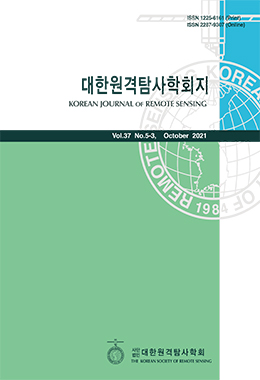천리안위성 2A호의 2분 주기 고속 관측(rapid-scan) 자료를 이용하여, 가시·수증기·적외 채널의 시간 해상도와 표적의 크기가 해당 채널의 중규모 대기운동벡터 생산에 미치는 영향을 분석하였다. 중규모 대기운동벡터 산출을 위하여 2-10분의 영상 시간 간격 변화 하에서 표적의 크기를 8×8에서 40×40 화소 크기로 변환시키며, 시·공간적인 조건 변화에 따른 벡터 생산량과 평균 속력, 오차 특성의 변화 양상을 비교하였다. 그 결과, 표적의 크기가 작을수록 위성의 시간 간격 변화에 따른 벡터 개수의 변화와, 표준화된 평균 제곱근 편차(Normalized Root Mean Squared Vector Difference; NRMSVD) 값의 변화가 더욱 뚜렷해졌다. 또한 고도별 오차 특성 분석 결과에서는 평균 속력이 낮고 대기 현상의 시·공간 규모가 작은 하층(700-1000 hPa)의 경우, 짧은 시간 간격의 영상 자료와 작은 표적을 이용하는 것이 벡터 산출에 더욱 유리하게 작용하는 것을 확인할 수 있었다. 위성의 시간 간격과 표적의 크기는 대기 순환의 시·공간 규모와 밀접한 연관이 있는 요소이다. 따라서, 대기운동벡터 활용 목적에 맞게 표적 크기와 위성 시간 간격을 최적화하는 과정이 필요하며, 중규모 기상현상의 실황 분석을 위한 대기운동벡터 산출 알고리즘에서는 표적 크기와 영상 시간 간격을 각각 16×16, 4분으로 설정해주는 것이 가장 적합하다고 판단된다.
This paper illustrates the impact of the temporal gap between satellite images and target size in mesoscale atmospheric motion vector (AMV) algorithm. A test has been performed using GEO-KOMPSAT-2A (GK2A) rapid-scan data sets with a temporal gap varying between 2 and 10 minutes and a target size between 8×8 and 40×40. Results show the variation of the number of AMVs produced, mean AMV speed, and validation scores as a function of temporal gap and target size. As a results, it was confirmed that the change in the number of vectors and the normalized root-mean squared vector difference (NRMSVD) became more pronounced when smaller targets are used. In addition, it was advantageous to use shorter temporal gap and smaller target size for the AMV calculation in the lower layer, where the average speed is low and the spatio-temporal scale of atmospheric phenomena is small. The temporal gap and the target size are closely related to the spatial and temporal scale of the atmospheric circulation to be observed with AMVs. Thus, selecting the target size and temporal gap for an optimum calculation of AMVs requires considering them. This paper recommends that the optimized configuration to be used operationally for the near-real time analysis of mesoscale meteorological phenomena is 4-min temporal gap and 16×16 pixel target size, respectively.




